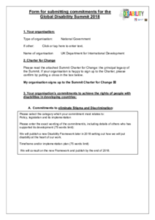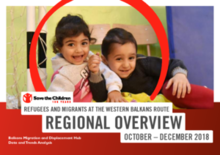Demographic Data
|
Sources: World Bank, UNICEF, UNDP HDR 2015, DHS 2011 |
Displaying 8491 - 8500 of 14391
This information sheet outlines provincial adoption provisions for Indigenous children.
In this form, the UK Department for International Development (DFID) outlines its commitments for the Global Disability Summit 2018, including its new policy position on children and young people with disabilities in institutions.
These Standard Operating Procedures (SOPs) for the inspection and monitoring of Residential Homes for Children (RHCs) in Ghana are intended to provide guidance to National, Regional and District DSW Officers on how to plan, conduct and report on RHC inspection and monitoring visits and how to enforce directives to either address gaps in compliance with the Standards and/or to close the RHC.
The revised Standards outlined in this document are aimed at strengthening the first National Standards for Residential Homes for Children (RHC) in Ghana, developed in 2010.
This Training Manual seeks to raise awareness of the content of the Prepare for Leaving Care: Practice Guidance, build knowledge and skills to support young people through the process of leaving care and help trainees to understand and develop some of the tools which are helpful in the leaving care process.
Este llamado pide a los gobiernos nacionales y locales, en coordinación con socios nacionales y globales, fortalecer la fuerza laboral del servicio social para mejorar los resultados de protección, salud y bienestar para niños, niñas, jóvenes, familias y comunidades como se describe en los Objetivos de Desarrollo Sostenible.
Data and Trend Analysis (DATA) Refugees and Migrants at the Western Balkans Route Regional Overview, covering period October - December 2018, describes key trends in migrations in the region, detailing information about the number of people on the move, demography (age, sex, country of origin, etc), behavioral patterns, and routes in use - with a focus on children, particularly unaccompanied children. Data in this report includes key trends in Bulgaria, North Macedonia, Serbia, Albania, Montenegro, Bosnia and Herzegovina, and Croatia.
El presente manual proporciona a todos quienes están comprometidos con la tarea de poner fin a la violencia contra los niños la mejor información posible sobre la manera de ejecutar las estrategias INSPIRE.
Catalyzing Business Skills is a suite of three financial literacy and business skills curricula developed by Making Cents International and Child Fund's Economic Strengthening to Keep and Reintegrate Children into Families (ESFAM) project in Uganda.
This report details a component of the UNSW national Long-term Outcomes of Forgotten Australians Study reported in No child should grow up like this which explored the in-care and after-care experiences of adults who spent their childhoods in institutions and foster care during the period 1930 to 1989. In this report, the focus is on Stolen Generations survivors and other Aboriginal and Torres Strait Islander individuals who participated in the research.








